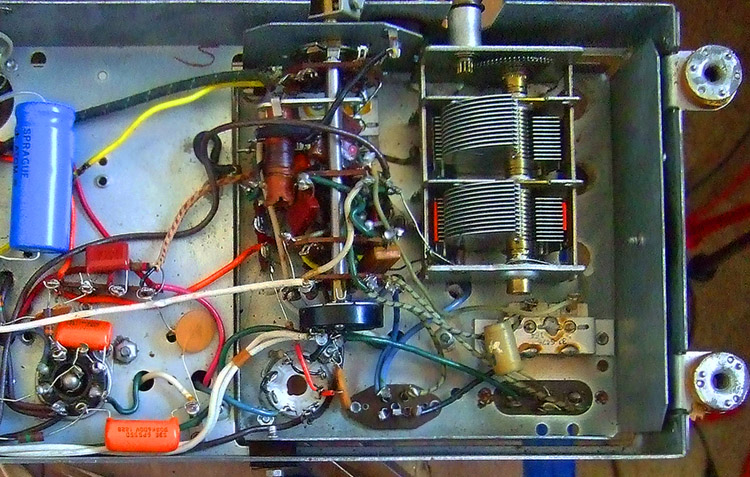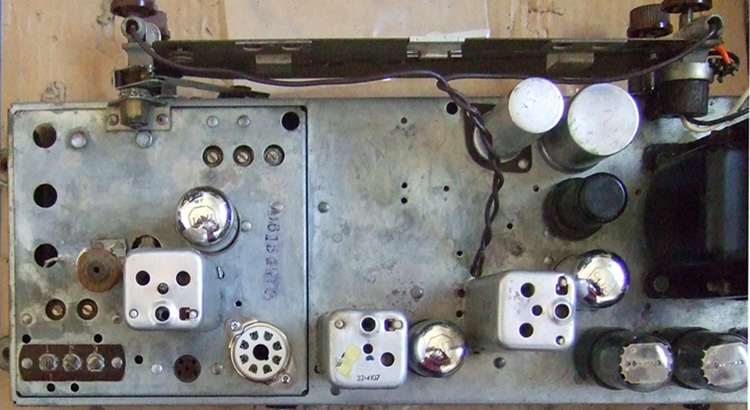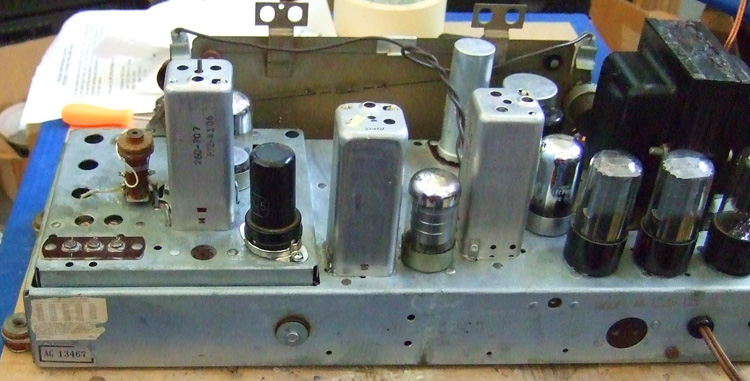Restoring a 46-1226 Code 125
Posts: 15,306
Threads: 532
Joined: Oct 2011
City: Jackson, NJ
I honestly hate loctals. This is the only type of tubes that seems to develop a film on the pins that fully breaks the contact. I haven't seen that in miniatures.
People who do not drink, do not smoke, do not eat red meat will one day feel really stupid lying there and dying from nothing.
Posts: 348
Threads: 48
Joined: Oct 2013
City: Tioga, Texas, USA
Ron;
I think you are right. I have some Octal sockets of the saddle mount type on hand but no Loctal sockets. Radio Daze has some but they are $2.25 apiece. I also noted that the tube that seems to exhibit the problem pegs the gain meter on the tube tester. The other 7H7 seems to show normal gain rise. That 1st IF 7H7 does not even show slow rise in emission - immediately pegs the gain meter in the tester. I think the tube has an internal short even though it does not show up on the tester. I need to check to see what type of gain characteristics the 7H7 has compared to common Octal IF tubes. Probably a 6SK7 would work fine. It is designed to work with AGC regulation.
Joe
Posts: 13,776
Threads: 580
Joined: Sep 2005
City: Ferdinand
State, Province, Country: Indiana
I just took a very quick look...7H7 is a semiremote-cutoff pentode, while a 6SK7 is a remote-cutoff pentode. A 6SG7 (semiremote-cutoff pentode) would be closer to a 7H7. The characteristics are not exactly the same but might be close enough for Gubmint work.
--
Ron Ramirez
Ferdinand IN
Posts: 348
Threads: 48
Joined: Oct 2013
City: Tioga, Texas, USA
Ron;
Yes a semi-remote cut-off 6SG7 would probably be best choice. What that says is that the tube will still exhibit some gain even if AGC is telling it to back off on gain. It makes for a slightly more sensitive receiver than the other choice. I think the only time you might want a remote cut-off type would be if you were combating a really strong BC band local signal. My son-in-law's dad lives in McPherson, KS and there is not a problem with really strong signals right there.
I just finished mounting a ceramic top-side saddle mount Octal socket which neatly covers the Loctal socket hole with room to spare. Next I will order a 6SG7 to install. I had one old Silvertone and one old Admiral AM AC/DC chassis that might have had a socket I could have used, but installing a bright shiny new socket looks better. I misplaced those chassis anyway. Next I need to check the pin-outs for the 6SG7, although I think they are the same as the 7H7.
Joe
(This post was last modified: 02-04-2018, 03:37 PM by Joeztech.)
Posts: 348
Threads: 48
Joined: Oct 2013
City: Tioga, Texas, USA
I just checked my RCA Tube Manual (RC15) and the 6SG7 has more gain than a 6SK7. I will order one from AES.
Joe
Posts: 348
Threads: 48
Joined: Oct 2013
City: Tioga, Texas, USA
A closer look at the pin-outs of the two tube types revealed that they are quite different:
7H7 6SG7
1 & 8 Filaments 2 & 7
7 Cathode 5
6 G1 4
3 G2 6
4 G3 3 & 5
2 Plate 8
G3 and Cathode are tied together in the 6SG7 but that won't matter much. In the 7H7, G3 is tied to ground externally. With the 7H7 the 68 ohm cathode resistor is not bypassed. With the 6SG7 it might be good to bypass the 68 ohm cathode resistor and G3, but may not be necessary. I will try leaving the cathode resistor un-bypassed first and if there is a problem I can always add a bypass capacitor.
So the layout of leads will be a bit different, but not a significant issue to deal with. There are two ground lances to utilize and I have plenty of wire and parts available.
The radio should not really care as far as gain is concerned since both tube types have identical gain at the same B+ voltage range.
I will do an updated schematic and leave it in an envelope inside the cabinet plus do an updated tube lay-out label to place inside the cabinet too. The 2nd IF appears to work OK so I will leave it as it is.
Joe
Posts: 13,776
Threads: 580
Joined: Sep 2005
City: Ferdinand
State, Province, Country: Indiana
Since you changed from local to octal socket, some rewiring is to be expected. The pinouts are usually quite different (i.e. location of plate, grids, cathode, filament leads). What is more important is to confer with a tube manual or online such as nj7p.org to make sure the characteristics of each tube are similar enough.
At least with an octal tube you won't have issues with poor tube pin to socket contact, as so often occurs with loctals.
--
Ron Ramirez
Ferdinand IN
Posts: 4,612
Threads: 51
Joined: Sep 2008
City: Sandwick, BC, CA
There are three possible sources of replacement Loctal sockets that I know of, one is to salvage some from a junker chassis, second would be to find some NOS ones someplace, and the third would be to look into the new production Chinese made Loctal sockets on fleabay, but in all three cases you will need to know the dimensions of the original sockets and of the new ones.
Regards
Arran
Posts: 348
Threads: 48
Joined: Oct 2013
City: Tioga, Texas, USA
Aaran;
I did find two versions on the Radio Daze site; SKT-8L-C1and SKT-8L-C2. One has lugs with holes to slip leads through and the other has lugs with no holes and are made for solder to a circuit board. The original Loctal sockets in this model have lugs with no holes and the wires are wrapped around the lugs. So the closest version from Radio Daze would be the ones made for circuit board use if its dimensions allow it to fit. The dimensions were not given, so I wrote them asking for that detail. I will report on the dimensions when I hear from them. The socket opening in the chassis is 1.035 inches and the rivet holes are 1.325 inches apart measured with my dial caliper. The bottom of the Octal socket I installed fit easily in the socket circle opening with some room to spare. I used 4-40 hardware to mount the new Octal socket.
I ordered a 6SG7 from AES and contacted a friend about getting some 6K6GT/G tubes for the push-pull output stage. I did measure the grid bias yesterday and it was at -19.9VDC at both output tubes. That is quite a lot higher than the -11V shown on the schematics for the various versions of this model. The resistor in the power supply that establishes this bias appears to be an original Philco part but measures 260 ohms instead of 165 ohms shown on at least some versions of the schematic that I see. That would explain the grid bias being higher than indicated.
I have been working from the schematics that jcassity posted plus a Beitman's schematic supposedly for the Code 125 version. I have been redrawing the Beitman's schematic to make it clear and easy to read. That has been helpful and everything I have found so far agrees with the chassis version that I have except for the 260 ohm resistor in the negative bias circuit, the absence of a field coil and the presence of a PM speaker. I also have downloaded the Rider's 47-1227 service data and it also agrees in many details with the 46-1226 Code 125 version. The strange thing about the Code 125 version I have is that it appears to have an original Philco permanent magnet speaker installed instead of a field core version. Even the 47-1227 version service data indicates a field core speaker was used. The schematic shows the speaker also is supposed to have a hum bucking coil in it. The connector for the speaker in this set has holes to accept the 4-prong male plug mounted on the speaker frame. There are only two leads going to the speaker in this set. I have no way of knowing if it ever had a different speaker or extra leads to it.
Joe
(This post was last modified: 01-23-2018, 07:18 AM by Joeztech.
Edit Reason: correction
)
Posts: 348
Threads: 48
Joined: Oct 2013
City: Tioga, Texas, USA
I finished the installation of the new Octal socket which will employ a 6SG7 IF amp tube when it arrives. The work went rather easily and the end result looks neat and clean. I did use a new 27K ohm 1/2 watt resistor for the B+ to the screen grid and a new 68 ohm 1/2 watt resistor for the cathode resistor. The IF transformer wires to the signal grid and the plate tube socket contacts were of adequate length and were easily moved to their new locations. I decided to take some new photographs of the area to show the new socket.



The Octal tube shown in the new socket is not an actual 6SG7, but a 6J5 just for illustration purposes.
Now I wait on the new tube. A friend has some new old stock 6K6GT tubes he is going to test match and send me so the end result should deliver the best possible sound that this radio is capable of.
Joe
Posts: 348
Threads: 48
Joined: Oct 2013
City: Tioga, Texas, USA
As a follow-up to the modification of the 1st IF from a 7H7 to a 6SG7, I did receive the new old stock Sylvania 6SG7 from AES on Friday. Yesterday I felt better after a Tylenol to help diminish the fever I was having from the flu and installed the new tube. A quick check with the substitute AM loop antenna showed that the reception is better than before with many more AM stations appearing all up and down the dial. So this particular tube is a good replacement (not substitute) for the original 7H7.
On another issue, the very slow warm-up, I note that after viewing several Philco schematics there are slight differences in how the output tubes are biased depending on whether they are 6K6GT or 6V6GT tubes. Here is a list I compiled of what I found:
46-1209 uses 6V6GT output tubes and a 150 ohm candohm resistor (no part number found for this one)
46-1226 Code 125 uses 6K6GT output tubes and a 265 ohm (measured) candohm resistor P/N 33-3435-7
47-1227 uses 6K6GT output tubes and a 165 ohm candohm resistor P/N 33-3435-1
47-1230 uses 6V6GT output tubes and a 135 ohm candohm resistor P/N 33-3435-2
So what I gather from the above information is that when Philco used a grid bias resistor that was higher resistance (producing slightly higher negative bias) when they used 6K6GT output tubes. When Philco used 6V6GT output tubes they used a lower value resistor and consequently less negative grid bias in order to turn on the 6V6GT tubes.
I know that this site has listings of the various Philco Block Capacitors by Philco P/N but is there a listing of values for Philco P/N candohm resistors?
I believe the candohm 33-3435-7 resistor that I find in this 46-1226 Code 125 radio should have been closer to 165 or 170 ohms. I think this particular candohm resistor has something wrong with it. The next step will be to find a suitable lower value of 150 ohms or 135 ohms to properly bias 6V6GT tubes. Otherwise if 6K6GT tubes are to continue to be used a 165 or 170 ohm resistor will be installed. Since I have two good 6V6GT tubes on hand and would have to order 6K6GT tubes I plan to install one of the lower values in place of the existing candohm resistor. I believe this will also correct the very slow to produce good audio problem. Other voltages are correct throughout the radio.
Joe
Posts: 619
Threads: 42
Joined: Mar 2017
City: Gap Mills Wv 24941
sounds to me like your rolling it back to a code 122 for that candohm. it was called R30 in runs/codes prior to code 125. runs of code 125 renamed it to R100
my actual candohm reading per my notes reads 272 ohms.
i can mail you my prints and notes,,, you make copies and such then send them back.
scott 304 772 3411
Posts: 348
Threads: 48
Joined: Oct 2013
City: Tioga, Texas, USA
Jcassity;
The schematic you posted in your thread was the one that I kept referring to. The schematic that I redrew was from a Beitman's schematic for the Code 125 produced in 1948 based on examination by them of a sample of this version. In comparing the values shown for the candohm resistor in the versions that are known to exist plus preceding years or successive year models shows how Philco changed their designs slightly for the values of this resistor. The actual negative voltage applied to the output tubes' signal grid varies depending on those values. I see negative voltages ranging from -11VDC to about -20VDC and values in between. What I may do is take a close look at the current in each output tube. A 10 ohm resistor can be placed in the cathode circuit of each tube and the resulting voltage measured will indicate the current conduction of each output tube. Then a comparison can be made to the specifications for the 6K6GT or 6V6GT tubes to see what the current is. Overall fidelity is impacted by how close to best operating parameters the tubes are performing. The range of values for the negative bias resistor mentioned shows that there is a considerable range permitted by Philco's designs. Some of this may be to optimize power output in some models and make some not as strong by comparison as a way of promoting the better sound of more expensive models. In general, the more negative the signal grid voltage becomes the lower the current in each output tube becomes. This extends tube life, while if the negative voltage is reduced the output tubes' current increases and power output increases up to a point. Output transformers are often changed depending on desired power output and frequency response. That is another area of investigation that needs to be considered when looking at the range of parts values and tube current observed.
I find that the permanent magnet speaker in the version that I have is a surprise as Philco continued to produce versions in later year models that used field core speakers. This particular unit may be somewhat of an experimental version in which Philco was trying some new ideas. I have not seen any indication that the speaker was ever changed from a PM type looking at the connections under the chassis.
Thanks for that extra bit of data about the value of the candohm resistor in your set. The one in this set measures close to 265 ohms.
Joe
(This post was last modified: 01-31-2018, 07:27 AM by Joeztech.)
Posts: 348
Threads: 48
Joined: Oct 2013
City: Tioga, Texas, USA
Today I finally solved the problem with the radio being very slow to produce audio and being very distorted at first when it did. I started by checking the audio at the detector diodes of the 7C6 using my oscilloscope. I had good audio there. I moved on to the grid of the 7C6 and had good audio there. There was also good audio at the plate of the 7C6 1st. audio tube - this all was done from a cold start. Yet the audio output would not come on for nearly two full minutes. I kept going with the scope moved further along the signal path, turning the set off until a cold start could be initiated again. Finally I reached pin 5 of the 6J5 Phase Inverter tube. When I placed the scope probe on the end of the .01 coupling capacitor to pin 5 I saw the lead move physically on the socket pin. I had forgotten to solder that end of the coupling capacitor when I had replaced it probably over a month ago! I suspect that what happened was that I interrupted my work and continued on later and just did not spot the loose connection until today.
The 265 ohm candohm resistor seems to work just fine now with adequate audio output, so it will stay in the set. It is working with two new 6V6GT output tubes in place of the OEM 6K6GT tubes, so things look normal from the standpoint of audio output level and distortion seems minimal. Jcassity mentioned that his set had a somewhat higher candohm negative bias resistor in it and worked well. At first I wondered if this set needed a 150 ohm resistor after changing to 6V6GT tubes, but that turned out not to be true.
There is no substitute for good troubleshooting techniques and a step by step procedure to follow. Proving good audio from the detector on was the key to establishing where the problem was happening.
Now I will be able to wrap this set up soon and present it to the owners.
Joe
Posts: 619
Threads: 42
Joined: Mar 2017
City: Gap Mills Wv 24941
good job!
i'm starting to believe more and more that i need a scope. what frequency where you tracing,, the 455kc? is that what you mean when you said you started checking for audio?
Users browsing this thread: 1 Guest(s)
|



